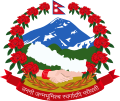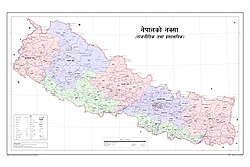
Back Nèpal ACE Непал ADY Nepal Afrikaans Nepal ALS ኔፓል Amharic Nepal AMI Nepal AN Nepal ANG نيبال Arabic نيپال ARY
Federal Democratic Republic of Nepal | |
|---|---|
| Motto: जननी जन्मभूमिश्च स्वर्गादपि गरीयसी (Sanskrit) Janani Janmabhumishcha Swargadapi Gariyasi "Mother and Motherland are Greater Than Heaven" | |
| Anthem: सयौँ थुँगा फूलका (Nepali) Sayaun Thunga Phulka "Made of Hundreds of Flowers" | |
Location of Nepal in dark green; territory claimed but controlled by India shown in light green | |
| Capital and largest city | Kathmandu[1] 28°10′N 84°15′E / 28.167°N 84.250°E |
| Official languages | Nepali[2] |
| Recognised national languages | All mother-tongues[3][4] (see Languages of Nepal) |
| Ethnic groups (2021)[5] | |
| Religion (2021)[6] | |
| Demonym(s) | |
| Government | Federal parliamentary republic |
| Ram Chandra Poudel | |
| Ram Sahaya Yadav | |
| K. P. Sharma Oli | |
| Bishowambhar Prasad Shrestha | |
| Legislature | Federal Parliament |
| National Assembly | |
| House of Representatives | |
| Formation | |
| 25 September 1768[7] | |
| 4 March 1816 | |
| 21 December 1923 | |
| 28 May 2008 | |
| 20 September 2015 | |
| Area | |
• Total | 147,516 km2 (56,956 sq mi) (93rd) |
• Water (%) | 2.8% |
| Population | |
• 2024 estimate | 31,122,387[10] (49th) |
• Density | 180/km2 (466.2/sq mi) (72nd) |
| GDP (PPP) | 2023 estimate |
• Total | |
• Per capita | |
| GDP (nominal) | 2023 estimate |
• Total | |
• Per capita | |
| Gini (2010) | 32.8[12] medium inequality |
| HDI (2019) | medium (142nd) |
| Currency | Nepalese rupee (Rs, रू) (NPR) |
| Time zone | UTC+05:45 (Nepal Standard Time) |
| Date format | YYYY/MM/DD |
| Drives on | left |
| Calling code | +977 |
| ISO 3166 code | NP |
| Internet TLD | .np |
Nepal,[a] officially the Federal Democratic Republic of Nepal,[b] is a landlocked country in South Asia. It is mainly situated in the Himalayas, but also includes parts of the Indo-Gangetic Plain. It borders the Tibet Autonomous Region of China to the north, and India to the south, east, and west, while it is narrowly separated from Bangladesh by the Siliguri Corridor, and from Bhutan by the Indian state of Sikkim. Nepal has a diverse geography, including fertile plains, subalpine forested hills, and eight of the world's ten tallest mountains, including Mount Everest, the highest point on Earth. Kathmandu is the nation's capital and the largest city. Nepal is a multi-ethnic, multi-lingual, multi-religious and multi-cultural state, with Nepali as the official language.
The name "Nepal" is first recorded in texts from the Vedic period of the Indian subcontinent, the era in ancient Nepal when Hinduism was founded, the predominant religion of the country. In the middle of the first millennium BC, Gautama Buddha, the founder of Buddhism, was born in Lumbini in southern Nepal. Parts of northern Nepal were intertwined with the culture of Tibet. The centrally located Kathmandu Valley is intertwined with the culture of Indo-Aryans, and was the seat of the prosperous Newar confederacy known as Nepal Mandala. The Himalayan branch of the ancient Silk Road was dominated by the valley's traders. The cosmopolitan region developed distinct traditional art and architecture. By the 18th century, the Gorkha Kingdom achieved the unification of Nepal. The Shah dynasty established the Kingdom of Nepal and later formed an alliance with the British Empire, under its Rana dynasty of premiers. The country was never colonised but served as a buffer state between Imperial China and British India. Parliamentary democracy was introduced in 1951 but was twice suspended by Nepalese monarchs, in 1960 and 2005. The Nepalese Civil War in the 1990s and early 2000s resulted in the establishment of a secular republic in 2008, ending the world's last Hindu monarchy.
The Constitution of Nepal, adopted in 2015, affirms the country as a secular federal parliamentary republic divided into seven provinces. Nepal was admitted to the United Nations in 1955, and friendship treaties were signed with India in 1950 and China in 1960. Nepal hosts the permanent secretariat of the South Asian Association for Regional Cooperation (SAARC), of which it is a founding member. Nepal is also a member of the Non-Aligned Movement and the Bay of Bengal Initiative.
- ^ "Nepal | Facts, History & News". www.infoplease.com. Archived from the original on 7 June 2020. Retrieved 29 June 2020.
- ^ "Nepal | Culture, History, & People". Encyclopædia Britannica. Archived from the original on 12 March 2012. Retrieved 29 June 2020.
- ^ "नेपालको संविधान २०७२" [Constitution of Nepal 2015] (PDF). 20 September 2015. Archived from the original (PDF) on 8 August 2019. Retrieved 16 July 2019 – via Nepal Law Commission.
- ^ Mandal, Bidhi; Nayak, Ravi (9 June 2019). "Why English?". Republica. Archived from the original on 23 September 2020. Retrieved 17 April 2020.
- ^ National Statistics Office (2021). National Population and Housing Census 2021, Caste/Ethnicity Report. Government of Nepal (Report). Archived (PDF) from the original on 14 October 2023. Retrieved 26 April 2024.
- ^ "Number of castes, ethnicities in Nepal increases to 142". The Kathmandu Post. 3 June 2023. Archived from the original on 12 July 2023. Retrieved 12 July 2023.
- ^ Subba, Sanghamitra (20 December 2019). "A future written in the stars". Nepali Times. Archived from the original on 31 January 2021. Retrieved 31 January 2021.
- ^ The Sugauli Treaty of 1816 rendered moot the degree of independence of Nepal. The sixth point of the treaty directly questions the degree of independence of Nepal. The fact that any differences between Nepal and Sikkim will be "referred to the arbitration of the East India Company" sees Nepal as a semi-independent or a vassal state or tributary of the British empire.
- ^ Formal recognition of Nepal as an independent and sovereign state by Great Britain.
- ^ "Nepal". The World Factbook (2024 ed.). Central Intelligence Agency. Retrieved 24 September 2022. (Archived 2022 edition.)
- ^ a b c d "World Economic Outlook Database, October 2023 Edition. (Nepal)". IMF.org. International Monetary Fund. 10 October 2023. Archived from the original on 31 October 2023. Retrieved 14 October 2023.
- ^ "Gini Index (World Bank Estimate) – Nepal". World Bank. Archived from the original on 8 June 2014. Retrieved 16 April 2020.
- ^ "Human Development Report 2019". United Nations Development Programme. 2019. Archived from the original (PDF) on 31 May 2020. Retrieved 16 April 2020.
- ^ "Nepal | Definition of Nepal by Oxford Dictionary on Lexico.com also meaning of Nepal". Lexico Dictionaries | English. Archived from the original on 17 August 2021. Retrieved 23 July 2020.
Cite error: There are <ref group=lower-alpha> tags or {{efn}} templates on this page, but the references will not show without a {{reflist|group=lower-alpha}} template or {{notelist}} template (see the help page).



